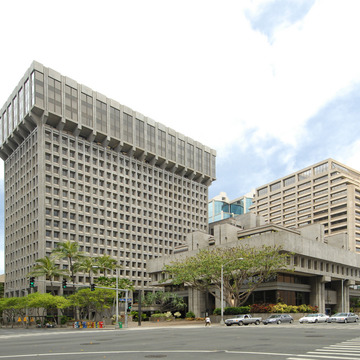Originally conceived as part of a four-block downtown revitalization plan prepared by Victor Gruen, Financial Plaza was the only block to be fully realized. Rendered in a Brutalist style and unified by its sandblasted brown aggregate surfaces, the complex includes three buildings: the six-story Bank of Hawaii, the twenty-one-story Pacific Century Tower (originally the Castle and Cooke Tower), and the twelve-story American Savings and Loan Association Building.
The highly sculptural Bank of Hawaii makes a strong visual statement with its dramatically cantilevered upper floors. Four cast-in-place girders form the walls between the fourth and sixth stories, allowing for the cantilever and eliminating the need for corner supports. All floors are either hung from these girders or are framed into structures supported by them. The pairs of piers centered on each side of the building support the girders. The Pacific Century Tower flows up from the ground on battered buttresslike elements, its precast-concrete window units steadily advancing skyward. The tower then changes style and proportion for the top three bracketed stories, which extend eight feet beyond the walls below. The American Savings and Loan Association Building combines elements from both its neighbors, its facade echoing the upper stories of the Pacific Century Tower and its paired piers reflecting the supports of the Bank of Hawaii.
This complex of three buildings sits back from Honolulu's main intersection, fronting a hardscape plaza softened by a step-down fountain framed by puhala and loulu palms. Other native Hawaiian trees used in the landscaping include coconut palms and a large wiliwili tree. The plaza was designed by renowned San Francisco landscape architect Lawrence Halprin, who designed Ghirardelli Square in San Francisco and the Franklin D. Roosevelt Memorial in Washington, D.C.
With 43 percent of the block devoted to Halprin's designed open space, Financial Plaza demonstrated to Honolulu the benefits of a more spacious, pedestrian-friendly downtown. The project was also one of the first in the commercial district to include outdoor sculpture; Bernard Rosenthal's striking Sun Disc presiding over the Bishop Street corner and Arnaldo Pomodoro's three cylindrical compositions on the Fort Street side.


